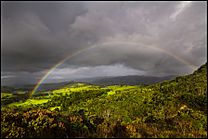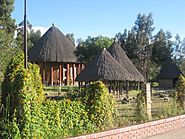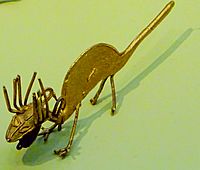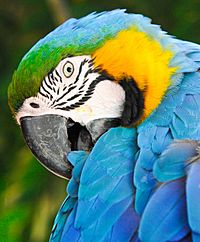Muisca religion facts for kids
The Muisca people lived in the central highlands of Colombia before the Spanish arrived. They had a special religion with many gods and goddesses, sacred places, and important rituals. The Muisca believed in a supreme being called Chiminigagua, who created light and the Earth. They didn't worship Chiminigagua directly, but honored him through his children: Chía, the Moon goddess, and her husband Sué, the Sun god. The idea of the Sun and Moon as husband and wife showed how men and women were seen as equal and how important marriage was.
The Muisca worshipped their gods at natural sacred sites like Lake Guatavita, the Siecha Lakes, and Lake Tota. They also built special temples, such as the Sun Temple in Suamox (which was like their "holy city") and the Moon Temple in Chía. During their ceremonies, priests called obgues performed rituals. The last public Muisca religious ceremony happened in Ubaque on December 27, 1563.
We know about the Muisca religion from writings by Spanish explorers like Gonzalo Jiménez de Quesada and Juan de Castellanos in the 1500s, and later by Lucas Fernández de Piedrahita and Pedro Simón in the 1600s. Today, scholars like Javier Ocampo López and Eduard Londoño continue to study their beliefs.
| A painting in Bosa showing Muisca gods and legends: • Sué (Sun god) • Chía (Moon goddess) • Bochica (teacher god) • Bachué and her son/husband (mother goddess) • the birds of Chiminigagua (creator god) • Huitaca as an owl (rebel goddess) • Tequendama Falls (created by Bochica) • Chibchacum (rain god) |
| Top - 0-9 A B C D E F G H I J K L M N O P Q R S T U V W X Y Z |
Muisca Religious Practices


Museo del Oro
The Muisca were very religious people. Their leaders were both political and religious figures. During their rituals, people would fast and also use plants like coca, tobacco, and yopo.
Yopo came from Anadenanthera trees that grew in the Llanos Orientales, east of the Muisca lands. The Muisca traded for the psychoactive seeds with other groups like the Achagua and Tegua. They would grind the seeds into a powder and inhale it using a hollow bird bone or a spoon. The plates used for inhaling yopo were often made of gold or tumbaga (a gold alloy) and were beautifully decorated. Many of these plates can be seen at the Museo del Oro.
Coca was used in rituals to predict the future and to help heal illnesses. It was often mixed with calcium to make it more effective. The calcium was stored in special containers called poporos, which were also often made of gold or tumbaga.
Muisca Gods and Goddesses
The Muisca worshipped many different gods and goddesses.
Chiminigagua - The Creator God
Chiminigagua was the Muisca's creator god. He made the light and the Earth. At the very beginning, everything was dark. Chiminigagua sent two large black birds into the sky. From their beaks, light appeared, making the cosmos bright.
Chía - Goddess of the Moon
Chía was the goddess of the Moon. She was one of the two main gods through whom Chiminigagua was honored. Chía represented the fertility of the Earth and its people. She was married to Sué, the Sun god.
Sué - God of the Sun
Sué was the god of the Sun. He was very important for Muisca farming. He and his wife Chía followed each other across the sky. They formed a perfect pair, especially during a solar or lunar eclipse.
Bachué - The Mother Goddess
Bachué was believed to be the ancestor of all Muisca people. She appeared from Lake Iguaque with a three-year-old boy. When the boy grew up, Bachué married him. They traveled around the Muisca lands, and each time she was pregnant, she had four to six children. The Muisca believed everyone could trace their family back to Bachué. When her children grew old, Bachué returned to Lake Iguaque with her son. After a final speech, they turned into two giant snakes and went into the water, making the lake a sacred place.
Bochica - Messenger of Civilization
Bochica was a messenger from Chiminigagua and a holy teacher for the Muisca. He was an old man with a beard, sent from heaven to teach the people. He taught them how to weave, make clothes, create ceramics, and understand social rules. He lived in Suamox, where people held yearly religious festivals for him. In Muisca religion, Bochica also created the Tequendama Falls, a large waterfall west of the southern capital, Bacatá.
Huitaca - Goddess of Joy
Huitaca was the goddess of happiness and pleasure. She was known for rebelling against Bochica's rules. She was a beautiful woman who taught people to live a long life full of art and dancing. When Bochica found out about her rebellion, he turned Huitaca into a white owl, or some stories say, the moon.
Chibchacum - God of Rain and Thunder
Chibchacum was the god of rain and thunder. He protected traders and working people. He was especially honored in Bacatá, where the Muisca offered him gold. If people disobeyed, he would flood the Bogotá savanna. Bochica stepped in and ordered Chibchacum to carry the Earth on his shoulders, like Atlas in Ancient Greece. Chibchacum was also believed to cause the many earthquakes in the central Andes.
Cuchavira - God of the Rainbow
The rainbow was represented by Cuchavira. He was born when Bochica created the Tequendama Falls. People honored him with gold and other offerings.
Chaquén - God of Sports and Fertility
Chaquén was the god of Earth's fertility and sports. He trained the Muisca for wars. Guecha warriors and farmers honored him to win battles and have good harvests. Chaquén also watched over rituals where people wore colorful feathered costumes. He is also credited with creating the Colombian national sport: tejo.
Nencatacoa - God of Arts and Dance
Nencatacoa was the Muisca god who protected artists, painters, builders, and those who enjoyed festivities. People in Muisca lands worshipped him at large celebrations where they drank chicha (a traditional drink). Nencatacoa was often shown as a fox or bear, dressed in gold. He helped the Muisca build their bohíos (houses) by carrying the heavy wooden poles.
Sacred Muisca Sites
To honor their gods, the Muisca went on special journeys called pilgrimages to their temples and other sacred places. These journeys included music and dances, as well as offerings. A group of priests, called ogques in their language Muysccubun, led these pilgrimages. The Spanish called them jeques or xeques. These priests were trained from childhood to become the religious leaders of the Muisca. An important site for Muisca pilgrimages was the Cojines del Zaque, located in the city of Hunza.
Muisca Temples
The most important Muisca temples were the Temple of the Sun in the sacred city of Suamox (which means "Dwelling of the Sun" in Muysccubun) and the Temple of the Moon in Chía, the town named after the Moon goddess. Here, people gathered to worship Sué and Chía. Other important temples were built in Guatavita, Bacatá, and Guachetá. It is said that these temples held images of their gods made of gold and silver. The sight of these richly decorated temples helped spread the legend of El Dorado, which attracted the Spanish conquerors.
Sadly, both the Temple of the Moon in Chía and the Sun Temple in Sogamoso were destroyed. A reconstruction of the Sun Temple has been built in the Archaeology Museum in Sogamoso.
Natural Sacred Sites
The Muisca believed many natural places were sacred. These included lakes, rivers, forests, and large rocks. People would gather at these sites to perform rituals and make offerings, mostly of gold and emeralds. Important sacred lakes included Lake Guatavita, Lake Iguaque, Lake Fúquene, Lake Tota, the Siecha Lakes, Lake Teusacá, and Lake Ubaque.
Muisca Offerings
The Muisca offered many valuable items to their gods. These included tunjos, which were small figures of people or animals made of gold or tumbaga (a mix of gold, silver, and copper). Many tunjos have been found and are now displayed in the Museo del Oro. Other offerings included emeralds, snails, special cloths, and food. Even parrots and other colorful birds were used in sacred rituals because they were believed to have a soul.
Special Offerings
In ancient times, Muisca families would sometimes offer one boy to the priests. These boys were raised as holy persons. When they reached a certain age (around twelve or fifteen), they would be offered in a special ceremony. This was considered a great honor for both the family and the boy. At the Cojines del Zaque, these boys, called moxas, were offered to Sué, the Sun god, just after sunrise.
See also
 In Spanish: Religión muisca para niños
In Spanish: Religión muisca para niños








